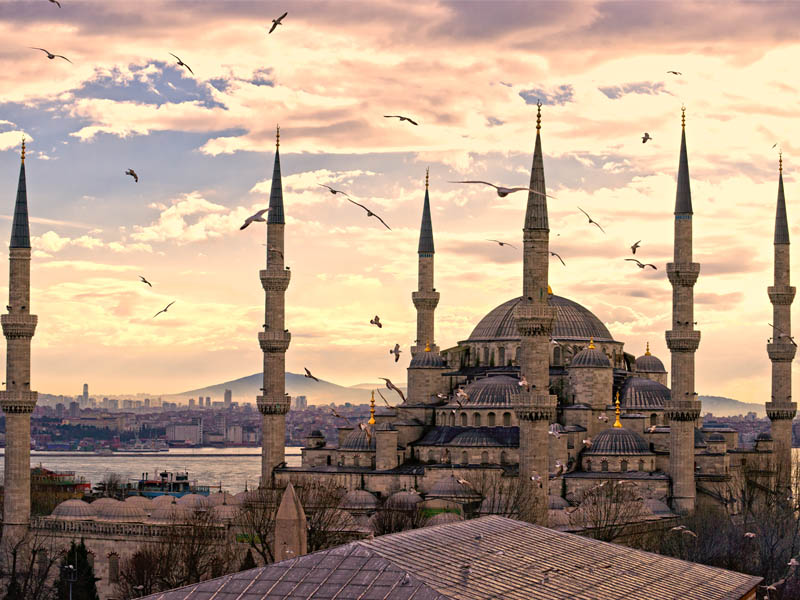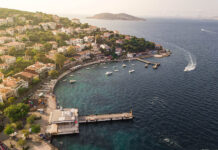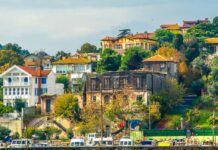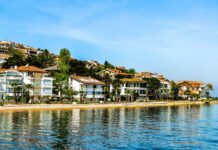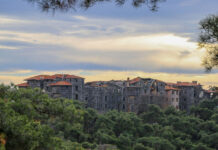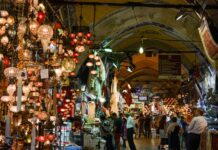The Blue Mosque is one of the most magnificent mosques in Turkey. It is also called as Sultanahmet Mosque or Sultanahmet Camii. Blue Mosque Istanbul is among the symbols of Istanbul thanks to its fascinating architecture. Despite it is not the mosque’s real name, Blue Mosque interior walls affected the naming of the mosque. Sultanahmet Mosque inside is covered with blue tiles. Blue Mosque tiles are painted by hand so you can see oriental art in every piece. Sultanahmet Mosque is in Sultanahmet square where you can also visit a lot of historic places such as Hagia Sophia and Basilica Cistern. It is also within walking distance to Grand Bazaar and Topkapı Palace.
Blue Mosque history leads back to Ottoman Empire and it takes a lot of tourist attraction. Ottoman architecture affected Sultanahmet Mosque Architecture; however, it is unique thanks to its domes and minarets. The Blue Mosque ceiling is a mesmerizing view. Who designed the Blue Mosque reached his goals even with its ceiling’s look. Why is the blue mosque called the blue mosque is one of the main questions visitors ask. After taking a look at its interior, everyone will understand the reason. The only thing you should do to get Blue Mosque Tickets. It is open to everyone every hour of the day apart from Blue Mosque praying time.
History of the Blue Mosque
It is not possible not to wonder about the history of the Blue Mosque. With all its beauty, standing close to Hagia Sophia, Blue Mosque took people’s interest from all over the world for centuries.
When Was the Blue Mosque Built?
The construction of the Blue Mosque began in August 1609. It continued until 1616-1617. During Ahmet I reign was the Sultanahmet mosque in Istanbul built. As a result, Blue Mosque contains the ruler’s tomb. Despite it was Ahmet I who commanded the construction, his successor Mustafa I signed the last accounts. Blue Mosque is named after Ahmet I. As a result, the original name of the Blue Mosque is Sultan Ahmet Camii. During his reign, Hagia Sophia was the head mosque. Hagia Sophia’s beauty affected him, as a result, he wanted a mosque that surpasses its beauty. Ahmet I wanted the Blue Mosque inside the Hippodrome. Furthermore, the mosque is in the exact place where Byzantine Palace was standing.
Who Designed the Blue Mosque?
The designer of Blue Mosque is Sedefkar Mehmet Agha. Sedefkar Mehmet Agha is the last student of the most famous and talented architect of the Ottoman Empire, Architect Sinan. Blue Mosque is the culmination of the career of him. In every piece of the Sultanahmet Mosque, you can understand his success in architecture.
The Architecture of the Blue Mosque
The Sultanahmet Mosque or Blue Mosque is a combination of traditional Ottoman and Islamic styles, and Byzantine style as a result of the impact of the Hagia Sophia. Sultanahmet Mosque is the last great mosque ending the classical period. The exterior of the Blue Mosque includes five main and eight secondary domes, and six minarets. The design of the mosque is without any flaws, completely symmetrical with the positioning of its domes and minarets. The highest dome of Blue Mosque is 43 meters high and 23.5 meter wide. The interior of the Sultanahmet Mosque contains 20.000 glazed ceramic tiles. They are all painted by hand in 60 different patterns. The name for that type of tiles are Iznik. There are 200 stained-glass windows to illuminate the structure.
Interesting Facts of the Blue Mosque
1) The Meaning of Iron Chain
In the court entrance of Blue Mosque’s western side, an iron chain is hanging from the ceiling towards the gate. It is not low enough to touch a person’s head unless they are riding a horse to the mosque. During that period, only the ruler had the right to ride a horse while entering the mosque. So, every time he entered, he had to bow his head. It is a symbol of the power of mosques where everyone is equal in front of God. Despite he is a great ruler of an empire, in the house of God, he had to bow his head to show his respect and belief in God.
2) Ostrich Eggs as Chandeliers
The architect of the Blue Mosque, Sedefkar Mehmet Agha, showed his wit by choosing a simple and natural solution to spider webs. Imagining the height of the ceiling, it would be hard to avoid spiders during that age. As using ostrich eggs among the glass chandeliers, he helped the mosque to avoid spiders.
3) Six Minarets or Golden Minarets
During the creation of the Blue Mosque, some rumors carried the information that the Sultan requested altın minarets but the architect built six minarets. (“Altın” means gold and “altı” means six in Turkish.) As a result of this misconception, the mosque had six minarets instead of golden ones according to a myth. Another myth is that it would be too expensive to build minarets from pure golden, so the architect came up with that idea. What makes it more complicated is that being a mosque with six minarets in Istanbul, it took Muslims’ interest in a negative way. Because the only mosque with six minarets was the one in Mecca which is the last Prophet’s mosque. As people criticized him harshly, Ahmet I had to build another minaret for Prophet’s mosque.
Several Tips for Your Blue Mosque Visit
- During a visit to a mosque, you should give importance to your clothing to respect the culture. If you are a man, you should avoid wearing shorts. If you are a woman, you should avoid wearing anything short or a sleeveless top. You can also bring a scarf to cover your hair unless you are okay to use scarves given in the entrance of the mosque.
- Do not come during praying times if you will not pray unless you might have to wait.
- You do not need tickets to enter the Blue Mosque. The entrance is free as it is a mosque.
- You will take off your shoes at the entrance. You can put them on the shelves at the entrance. However, someone else can take your shoes by mistake or can steal them. So, we advise you to take one of the plastic bags given to carry your shoes.
Frequently Asked Questions About Blue Mosque
Blue Mosque opening hours should not worry you. The mosque is open every day. However, it is still a place for praying place so during praying times it is not open to visitors. It is only open to people who will pray during those times. As Muslims pray five times a day, you should avoid visiting close to praying times. Appropriately praying takes 1 hour. Only on Fridays, during midday prayer, it can take up to 2 hours. To make sure you can check praying times of the day you will visit because it can change depending on which month you will visit.
The distance between the Blue Mosque and Istanbul Airport is 45.3 km. If you travel by a taxi, it will take around 45-60 minutes depending on the traffic.
You can get to the Blue Mosque by taking an airport bus called Havaist. It will bring you to Beyazit where Grand Bazaar is in 110 minutes. At this point, it is only within walking distance to Sultan Ahmet. However, you can take the tram from Beyazit, and get off after 2 stops. It will only take 3 minutes. Do not forget that Blue Mosque’s name is Sultan Ahmet Mosque in Turkish if need help with the address.
You can take airport busses from Sabiha Gökcen to Taksim then get on the metro to Yenikapı direction. You should get off at Istanbul University station (3 stops) and walk to the tram stop to take a tram to Sultanahmet.
If you do not want to use a taxi, the second way is to take the tunnel from Taksim station to Kabataş (1 stop) and taking the tram to Sultanahmet from Kabataş stop.
All of the suggested trips will take approximately 1,5 hours. For an easy trip, you can download Istanbul Metro Map.
Blue Mosque is in the Sultanahmet Square, Istanbul. The other name of this area is “historical peninsula”. Because that area of Istanbul consists of most of the most historical pieces of Istanbul.




















